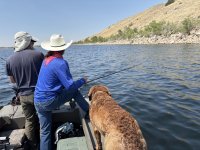We have several frost free lawn hydrants on the property here in Wyoming. I have one that started leaking (we were messing in the area and apparently jostled a fitting that wasn't, but now is leaking). The alternative to an easy fix is digging a 7' deep hole in the ground, so I'm hoping to avoid that.
The unit itself works absolutely fine.
The leak that just started is between the brass fitting that contains the valve at the bottom of the hydrant 7' down (3/4 inch female pipe thread) and the elbow that it is attached to (3/4 inch male pipe thread). I noticed well pump cycling when it shouldn't and opening and closing the supply inside the house shows pressure bleeding down. We are very lucky because this hydrant is installed inside a 4" piece of PVC (7' deep straight into the ground) - these are usually buried in the soil and have to be dug up to be messed with (they can be serviced from above/inside to rebuild, but that isn't the issue).
I removed the hydrant at the joint 7' down and checked it for function and reinstalled. There was no pipe dope on the joint on removal, but looking with a fiber optic inspection camera there are remnants of teflon tape down there. I put it together with a bunch of pipe dope and it was pretty clear that the joint bottomed out rather than tightened on the tapered threads (fiber optic camera confirms that that the female is/was deeply seated on the male). The leak is at the junction, confirmed with the camera, I'm seeing weeping there.
Were the male thread available I'd wrap with a generous amount of thick teflon tape over pipe dope, but that isn't an option. I've searched for a curing type pipe dope product, but can't seem to find something suited for the job. I could epoxy the joint together (I'd never get it apart, but I'd be ahead for now). It seems like some sort of RTV or curing caulk would work, but I don't have an idea of something suited for the continuous wet. Off label use would be fine if someone has an idea of something that would seal and hopefully be removable in the future.

The unit itself works absolutely fine.
The leak that just started is between the brass fitting that contains the valve at the bottom of the hydrant 7' down (3/4 inch female pipe thread) and the elbow that it is attached to (3/4 inch male pipe thread). I noticed well pump cycling when it shouldn't and opening and closing the supply inside the house shows pressure bleeding down. We are very lucky because this hydrant is installed inside a 4" piece of PVC (7' deep straight into the ground) - these are usually buried in the soil and have to be dug up to be messed with (they can be serviced from above/inside to rebuild, but that isn't the issue).
I removed the hydrant at the joint 7' down and checked it for function and reinstalled. There was no pipe dope on the joint on removal, but looking with a fiber optic inspection camera there are remnants of teflon tape down there. I put it together with a bunch of pipe dope and it was pretty clear that the joint bottomed out rather than tightened on the tapered threads (fiber optic camera confirms that that the female is/was deeply seated on the male). The leak is at the junction, confirmed with the camera, I'm seeing weeping there.
Were the male thread available I'd wrap with a generous amount of thick teflon tape over pipe dope, but that isn't an option. I've searched for a curing type pipe dope product, but can't seem to find something suited for the job. I could epoxy the joint together (I'd never get it apart, but I'd be ahead for now). It seems like some sort of RTV or curing caulk would work, but I don't have an idea of something suited for the continuous wet. Off label use would be fine if someone has an idea of something that would seal and hopefully be removable in the future.






